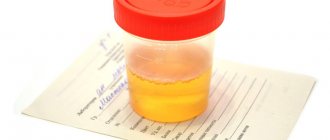1st trimester
(from the moment of fertilization to 14 weeks)
- general analysis of urine and blood;
- blood type and Rh factor (if Rh is negative, the husband also donates blood for the group and Rh factor);
- biochemical blood test (total protein, urea, creatinine, glucose, liver enzymes (AST, ALT), total bilirubin, direct bilirubin, total cholesterol);
- coagulogram or blood clotting (fibrinogen, platelets, platelet aggregation, clotting time, bleeding time, prothrombin index, APTT - activated partial thromboplastin time);
- blood for syphilis (RW reaction);
- blood for HIV infection and viral hepatitis (B and C);
- smear from the vagina and cervix for microflora (fungi and gonococci) and cytological examination;
- examination for sexually transmitted infections (according to indications): chlamydia, ureaplasmosis and others;
- double test (at 11-14 weeks): determination of plasma protein A (PAPP-A) and beta-hCG to exclude severe malformations (Down syndrome, Edwards syndrome);
- blood for rubella and toxoplasmosis (detection of type M and G antibodies).
2nd trimester
(from 14 to 28 weeks)
- general urine test at each appearance;
- general blood test before going on maternity leave (30 weeks);
- coagulogram according to indications;
- biochemical blood test before maternity leave;
- smear from the vagina and cervix for microflora (fungi and gonococcus), cytological smear as indicated;
- blood for HIV infection and viral hepatitis, syphilis before maternity leave;
- blood for antibodies, PCR of urine, vaginal discharge for rubella, cytomegalovirus and toxoplasmosis;
- triple test: beta-hCG, estriol and alpha-fetoprotein (AFP) at 16-18 weeks.
3rd trimester
- general urine test at each appearance;
- complete blood count at 30 and 36 weeks;
- smear for gonococci and fungi at 30 and 36 weeks;
- blood for syphilis, HIV infection and viral hepatitis at 30 and 36 weeks;
- coagulogram according to indications;
- biochemical blood test at 30 weeks;
- blood for antibodies to rubella and toxoplasmosis as indicated.
Ph of urine during pregnancy - depends on the sex of the child?
K.women often test their urine pH during pregnancy. Urinalysis is one of the most commonly performed tests during pregnancy, and its pH is one of the standard parameters measured. Find out what high urine pH indicates during pregnancy. Is there a connection between the pH of a pregnant woman’s urine and the gender of the child?
The need for laboratory tests
General analysis of blood and urine (CBC and UAM)
A general blood test determines the number of red blood cells and hemoglobin, which are necessary to carry oxygen. The CBC also examines the number of leukocytes and ESR, which are normally slightly increased during pregnancy. Platelets are involved in blood clotting; their determination during pregnancy is also necessary.
In OAM, the content of leukocytes, the presence/absence of protein, the density and reaction of urine and the presence of pathological structures and substances (casts, bacteria, glucose and others) are studied. OAM is the most often performed test that helps to suspect or determine the pathology of pregnancy (it is taken at each appointment).
Blood type and Rh factor
Blood group and Rh factor are necessary in case of emergency blood transfusion due to bleeding (for example, placenta previa); in case of negative Rh, a blood group and Rh factor test is necessary to exclude or treat Rh conflict.
Blood chemistry
Considering the increased load during gestation on all organs of a pregnant woman, a LBC is taken twice during the entire pregnancy (more often if indicated), which allows you to evaluate the functioning of the internal organs.
Blood for syphilis, viral hepatitis and HIV infection
The study is carried out three times during pregnancy and allows us to identify the listed infections, the presence of which adversely affects the development of the fetus, as well as the condition of the woman during pregnancy.
Smear for microflora and cytology from the cervix and vagina
Microflora smears are taken three times during pregnancy and help identify colpitis and cervicitis, which can cause infection of the membranes and fetus. Cytological examination excludes precancerous and cancerous processes of the cervix.
Blood for rubella, toxoplasmosis and cytomegalovirus
Antibodies of the IgM and IgG class to the listed infections are determined and make it possible to identify acquired immunity or its absence, as well as an acute process, the presence of which is unfavorable for the fetus.
Coagulogram
Indicators of the blood coagulation system during pregnancy are slightly increased; analysis of the coagulogram allows one to identify the risk of thrombosis in a woman, miscarriage and premature birth. Also, a blood clotting study is necessary to confirm gestosis and its treatment.
Double and triple test
It is carried out to determine the degree of risk of congenital pathology of the fetus and chromosomal disorders.
Urine pH during pregnancy
During pregnancy, urine is checked several times. For the first time at the very beginning. Then after about 10-15 weeks and then approximately every 5 weeks until the 38th week of pregnancy. Then more often, every week or two, until the last examination, immediately before birth. In total, an average of 7 such tests are carried out. The attending physician must monitor the “schedule”. A general urine test is aimed at monitoring kidney function and identifying possible diseases of the urinary system. Among the many parameters, the following are noted:
- level of protein in urine.
- sugar level
- ketone levels
- number of red blood cells,
- urine color,
- urine clarity
- urine smell
- specific gravity of urine
- urine ph.
This is especially important during pregnancy, as any infections can compromise the safety of mother and fetus.
When is a general clinical urine test prescribed?
A general (clinical) urine test is prescribed in the following cases:
- as part of an annual preventive examination (screening);
- during routine examination of pregnant women;
- during the initial diagnosis of any disease;
- for diseases of the urinary system (pyelonephritis, cystitis, etc.);
- if you suspect diabetes mellitus;
- to assess the course of the disease and the effectiveness of treatment;
- persons who have had a streptococcal infection (angina, scarlet fever), for monitoring in order to early detect possible complications.
Urine pH during pregnancy is normal
Ph is an indicator that determines the reaction of urine:
- sour
- base
- neutral.
The acidity-alkalinity (ph) scale, known from chemistry, ranges from 0 to 14. The closer to zero, the more acidic the reaction; the closer to 14, the more alkaline. 7 - neutral reaction. Urine pH values typically range from 4.5 to 8 on this scale, with a value of 6-6.5 considered normal . This means that human urine should be slightly acidic. The pH of urine during pregnancy should be more acidic and should be around 5.5.
Special urine tests
Urine culture
It is mandatory if bacteria were detected in a general urine test.
Purpose of the study. It is performed to determine the number of bacteria, their type and sensitivity to antibacterial drugs.
Rules for collecting urine for analysis. To obtain the correct result of this analysis, urine must be collected after thoroughly toileting the external genitalia, covering the vagina with a cotton swab. You need to collect a medium portion of urine in a sterile container, screw the lid on tightly and deliver it to the laboratory within one and a half to two hours.
Urine culture is prepared on average from 7 to 10 days and allows the doctor to decide whether antibacterial treatment is needed and with what drugs. If there is a clinical picture of inflammation, before obtaining culture results, antibacterial treatment is carried out with a broad-spectrum antibiotic (acts on a wide range of bacteria), and in the case of an asymptomatic course of the disease or mild inflammation, treatment is not carried out until the test results are obtained.
Urinalysis according to Nechiporenko
This is a special urine test that shows the content of red blood cells, white blood cells and casts in 1 ml of urine.
Purpose of the study. This test is prescribed if there is a suspicion of an inflammatory process in the organs of the urinary system in a pregnant woman, if there are changes in the general urine test. It gives more accurate results than a general urine test, and also allows you to monitor the treatment over time.
Rules for collecting urine. Urine for analysis according to Nechiporenko is collected in the same way as for a general urine analysis.
Parameters studied
- The number of leukocytes - normally they should be less than 2 thousand per 1 ml . An increase in the number of leukocytes indicates the presence of pyelonephritis (inflammatory disease of the pelvis and cups of the kidneys).
- The number of red blood cells is normally less than 1 thousand in 1 ml. An increase in the number of red blood cells indicates the development of glomerulonephritis (inflammation of the kidney glomeruli).
- The number of cylinders is normally less than 20 in 1 ml. The detection of an increased content of cylinders indicates arterial hypertension, diseases of the cardiovascular system, and can occur with early toxicosis of pregnant women.
Urine analysis according to Zimnitsky
Purpose of the study. This test is prescribed to clarify the ability of the kidneys to concentrate and dilute urine and to identify hidden edema. The study may be necessary if you suspect the development of preeclampsia, renal failure, infections of the urinary system, as well as diabetes mellitus.
Rules for collecting urine. For urine analysis according to Zimnitsky, urine is collected over the course of a day (24 hours) into 8 containers (jars), and the amount of liquid drunk must be taken into account (the pregnant woman writes down how much liquid she drinks during the day, taking into account soups, fruits and vegetables). At 6 am, a woman urinates in the toilet, then all subsequent urine is collected in jars.
Total 8 servings:
- 1 serving - from 6-00 to 9-00 hours,
- 2 servings - from 9-00 to 12-00 hours,
- 3 servings - from 12-00 to 15-00 hours,
- 4 servings - from 15-00 to 18-00 hours,
- 5th portion - from 18-00 to 21-00,
- 6 servings - from 21-00 to 24-00 hours,
- 7 portion - from 24-00 to 3-00 o'clock,
- 8th portion - from 3-00 to 6-00.
The jars are signed and delivered to the laboratory.
Parameters under study. The quantity and specific gravity of urine in each portion is assessed. Normal kidney function is characterized by:
- daily urine volume is about 1.5 liters;
- predominance of daytime urination over nighttime urination;
- excretion in urine of approximately 70-80% of the liquid drunk per day;
- the specific gravity of urine in at least one of the portions is not lower than 1.020-1.022;
- significant fluctuations during the day in the amount of urine in individual portions (from 50 to 400 ml) and the specific gravity of urine (from 1.003 to 1.028).
Deviations from these standards indicate a violation of the kidneys.
Rehberg's test
Purpose of the study. This test is used to determine the ability of the kidneys to filter urine. It is mandatory for all pregnant women with gestosis, urinary tract infections, kidney diseases, and diabetes.
Rules for collecting urine. Before the test, intense physical activity, strong tea and coffee are excluded. Urine is collected during the day in one container, which is stored in the refrigerator during the entire collection time. After completing urine collection, measure the contents of the container, be sure to mix it and immediately pour 70-100 ml into a special container or jar and deliver it to the laboratory, reporting the total volume of urine collected per day.
When urine is delivered to the laboratory, blood is drawn from a vein for creatinine.
Parameters under study. The method is based on assessing glomerular filtration based on the rate of purification of blood plasma from creatinine, a special product of protein breakdown. This indicator can be determined if you know the concentration of creatinine in the blood, in the urine and the daily volume of urine. This indicator is calculated using a special formula and is called creatinine clearance. Normally, the value of this indicator ranges from 75 to 134 ml/min/1.7 m2. A decrease in the level of renal filtration indicates kidney damage and occurs with severe complications of pregnancy - gestosis, kidney diseases (pyelonephritis, glomerulonephritis), diabetes mellitus, arterial hypertension, urolithiasis.
Urine at 17-KS
This test was previously widely prescribed to pregnant women to determine the hormones produced by the cortex of the endocrine glands - the adrenal glands. For analysis, urine was collected over the course of 24 hours, mixed, and a small part was poured and delivered to the laboratory indicating the total amount of urine collected. An increase in the concentration of 17-ketosteroids in the urine indicated excess production of hormones in the body of a pregnant woman, on the basis of which the doctor prescribed hormonal drugs. However, at present, the determination of these substances in urine is considered uninformative and is not used during pregnancy.
Urine tests are very simple to perform and very informative for the doctor; they allow you to promptly identify the slightest changes in the body of the expectant mother and promptly begin treatment, which helps prevent serious complications on the part of the pregnant woman and the unborn baby.
High urine pH during pregnancy
High urine pH during pregnancy may be a cause . This means that the urine is clearly alkaline. A urine pH of 8 during pregnancy may mean that the kidneys are unable to acidify the urine or that the urinary tract is infected with bacteria that break down ammonia. High urine pH during pregnancy can also indicate hyperkalemia, which is excess potassium in the body, and can also be the result of a low-meat lifestyle and diet.
Urine pH during pregnancy and the gender of the child
On online forums you can often come across the question: urine pH during pregnancy and the gender of the child . Can you tell from urine pH whether the baby is a boy or a girl? There is a myth that a pregnant urine pH of 5-6 means the birth of a girl, and 7-8 means a boy. But just... the key word is “fortune teller”. This type of advice is displayed on forums and portals along with advice on how to find out the gender of a baby using baking soda or watching a wedding ring spin on a string over the mother's belly. Therefore, you should not trust such practices.
Specialists
Petreykov Evgeniy Rafailovich
If you are planning a pregnancy, IVF, or have a history of fetal failure in the first trimester, contact Dr. Petreikov.
A gynecologist of the highest category, Candidate of Sciences, will help determine the risk and cause of obstetric complications, and also prescribe supportive treatment for a genetic predisposition to thrombosis.
Akhmedova Larisa Maratovna
Obstetrician-gynecologist with experience in a famous Israeli clinic, expert in monitoring pregnancy and the postpartum period.
Performs surgical operations: intimate plastic surgery, removal of polyps, treatment of erosion with Surgitron radioknife. Provides consultations and examinations to couples with suspected infertility.
Bitsadze Victoria Omarovna
Gynecologist-hemostasiologist, professor, doctor of medical sciences.
The doctor's profile is management of high-risk pregnancies, including in women with genetic thrombophilia and a tendency to spontaneous bleeding. Develops effective treatment regimens for infertility associated with autoimmune pathologies and hemostasis disorders.







